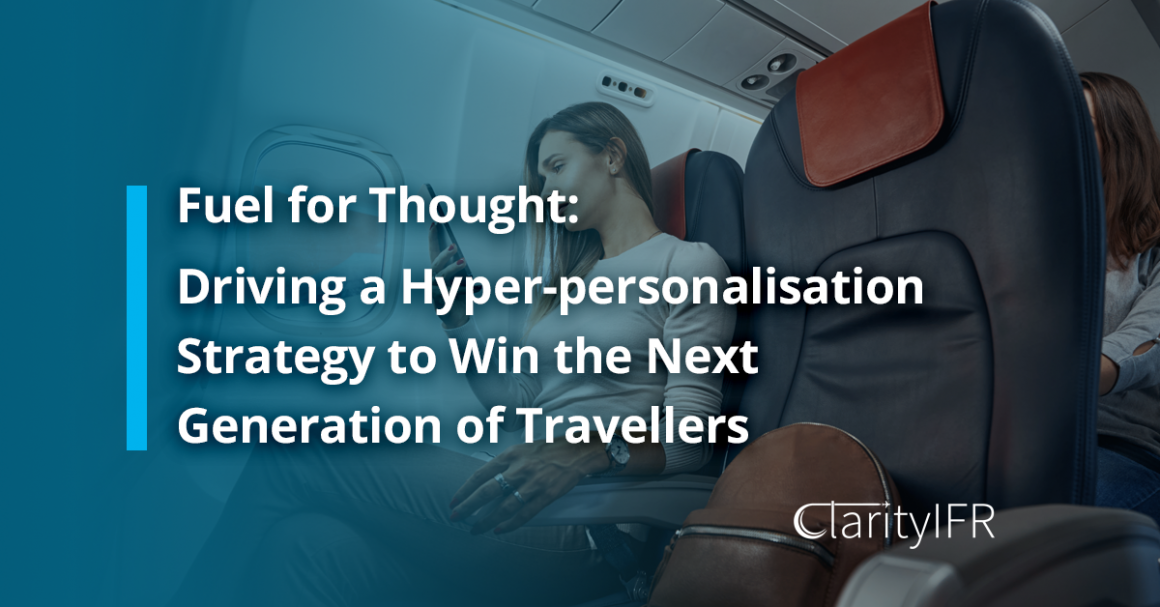Did you know travel is going to be greatly affected by technology advances in the next 10 years? Skyscanner’s Future of Travel Report Series has identified the way travel will change in the next decade and has predicted hyper-personalisation as the future of travel. Allowing the aviation industry to provide a higher level of personalisation than ever before.
Staying competitive means embracing advanced technologies to reimagine the passenger experience. This being said, hyper-personalisation is on the horizon. It’s an advanced strategy that harnesses real-time data, analytics, AI, and automation to craft tailored offers, services and experiences that align perfectly with customers’ desires.
While this contributes to two major purposes:
- To reduce costs
- To improve efficiency
It’s also about connecting customers with what they love, and hyper-personalisation does this seamlessly through a blend of data, analytics, AI, to understand behaviours. The airline sector is no different and is a solution to improve the operation of ancillaries.
But who already uses hyper-personalisation to fuel success? Starbucks, and it has turned to a hyper-personalised in-app experience with real-time offers based on preferences, activity, and past purchases, leading to increased revenue and transactions.
Hyper-personalisation is not just limited to coffee giants like Starbucks, it holds immense potential for airlines too. Imagine a world where airlines can optimise their in-flight retail offerings based on passengers’ preferences, past activity and purchasing history in real-time. This means stocking fewer items, aligning with cost reductions, enhancing efficiency, and boosting sales of popular products.
Hyper-personalisation isn’t just a buzzword; it’s a strategy that’s taking off in the airline industry making air travel more enjoyable and profitable for both airlines and passengers. By harnessing the wealth of data available, airlines are trying to become more tailored and more sophisticated merchandisers, and here’s a few reasons why:
Load Less, Sell More: The route towards sustainability. It’s about reducing unnecessary inventory, ensuring every item onboard has a purpose, and ultimately increasing ancillary revenue.
The key point is don’t fly what you don’t sell. Deploy solutions that optimise conversion rates through dynamic bar-sets, freeing the crew from administering unwanted product, allowing them more time to deliver a tailored passenger experience, and not burning fuel on unsold products.
Customised Shopping Experiences: This level of customisation ensures that passengers are presented with offerings they are genuinely interested in, using demographics, destination, and flight times to an advantage to determine what items will most likely sell, and what to stock more of – increasing the likelihood of making a purchase.
Optimised Pricing Strategies: One of the primary differentiators for consumers when considering different brands with similar products or fill similar needs for the individual is price. Price should be a key consideration to ensure suitable profitability for the organisation – while providing clear and competitive value.
After scanning vast amounts of data and analysing different pricing scenarios, AI tools can generate pricing suggestions. Usually from past transactions, pricing of competitors, contextual data, to conduct a win/loss analysis.
The findings can help airlines gauge the sensitivity of passengers to price points for any given product. It is a solution that can help airlines predict the price optimisation strategy that is most likely to generate sales and deliver margin whilst monitoring market trends and customer preferences.
Cost-Savings: Airlines can reduce operational costs and increase operational efficiency, as a result, increasing profitability and market competitiveness. For example, airlines can automate their inventory management, pricing, and revenue management processes to optimise their operations. Using AI algorithms, they can analyse historical data and current market trends to form real-time pricing, product and crewing decisions, thus reducing the complexity of manual labour and human error.
Challenges and Considerations: Privacy concerns must be addressed, and passengers should have control over the data they share. Airlines must also invest in robust cybersecurity to protect sensitive passenger information. Additionally, airlines will need to strike a balance between personalization and overstepping boundaries. Passengers should feel that their preferences are respected and valued rather than intruded upon.
That’s why we are fully committed to cyber security with ISO 27001 in place, having technologies, processes, and controls in place to protect our systems, network, and data from cyber-attacks.
As technology continues to advance and passengers demand more personalised experiences, we can expect hyper-personalisation to become the new norm in the airline industry. Airlines that embrace this trend will not only stay competitive but also set a new standard for excellence in passenger service.
Related Articles
How IT Innovations Propel Airlines Towards Net Zero Carbon Emissions by 2050
How Customer Segmentation is Transforming the Airline Industry
Creating Customer Value Through Dynamic Data-Driven Retailing

